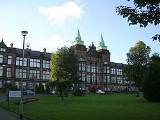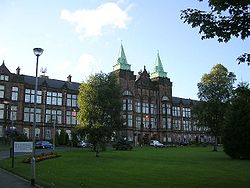
Jordanhill College
Encyclopedia

Jordanhill
Jordanhill is an affluent area of the West End of the city of Glasgow, Scotland. The area consists largely of terraced housing dating from the early to mid 20th century, with some detached and semi-detached homes and some modern apartments....
, Glasgow
Glasgow
Glasgow is the largest city in Scotland and third most populous in the United Kingdom. The city is situated on the River Clyde in the country's west central lowlands...
, Scotland
Scotland
Scotland is a country that is part of the United Kingdom. Occupying the northern third of the island of Great Britain, it shares a border with England to the south and is bounded by the North Sea to the east, the Atlantic Ocean to the north and west, and the North Channel and Irish Sea to the...
, is now home to the Faculty of Education
University of Strathclyde Faculty of Education
The Faculty Of Education is one of the 5 faculties which make up The University of Strathclyde. in Glasgow, Scotland. The Faculty itself is split up into the a number of Educational Departments which offer undergraduate and postgraduate courses....
of the University of Strathclyde
University of Strathclyde
The University of Strathclyde , Glasgow, Scotland, is Glasgow's second university by age, founded in 1796, and receiving its Royal Charter in 1964 as the UK's first technological university...
. Within the University of Strathclyde faculty of education, departments include Childhood and Primary Studies, Creative and Aesthetic Studies, Curricular Studies, Educational and Professional Studies, and Sport, Culture
Cultural studies
Cultural studies is an academic field grounded in critical theory and literary criticism. It generally concerns the political nature of contemporary culture, as well as its historical foundations, conflicts, and defining traits. It is, to this extent, largely distinguished from cultural...
and the Arts
ARts
aRts, which stands for analog Real time synthesizer, is an audio framework that is no longer under development. It is best known for previously being used in KDE to simulate an analog synthesizer....
.
The Faculty also is the home to the Glasgow School of Social Work, a joint department with the University of Glasgow
University of Glasgow
The University of Glasgow is the fourth-oldest university in the English-speaking world and one of Scotland's four ancient universities. Located in Glasgow, the university was founded in 1451 and is presently one of seventeen British higher education institutions ranked amongst the top 100 of the...
.
Professor Jill Bourne is Dean of Education, with vice deans Brian Green, Dr P Dougall and Professor Effie Maclellan.
History
Jordanhill College of Education can trace its origins to the Dundas Vale Normal Seminary which, when it opened under David Stow in 1837, was the first purpose-built institution in Europe for the training of teachers. Eight years later, following the Disruption - the split between the Church of Scotland and the Free Church of Scotland - Stow led most of the staff and students out of Dundas Vale to found a rival Free Church Seminary. For the rest of the century, Protestant teacher training in Glasgow was split between colleges run by the two church factions. When, later in the century, teacher training courses were added at a Roman Catholic college and at Glasgow University, the result was a confusion of courses run by institutions with poor facilities and inadequate resources, a situation which was mirrored in other parts of Scotland.The Scottish Education Department (SED) therefore decided that teacher training could no longer be left to the churches but must become a national concern. Rather than administer this directly, SED set up four Provincial Committees based on the notional provinces of the four ancient universities, Glasgow, Edinburgh, St. Andrews and Aberdeen. These Provincial Committees, however, operated within a tight framework of control by SED which provided the finances, approved the courses and inspected the training centres.
The Glasgow Provincial Committee held its first meeting in 1905. From the start it aimed to provide a new building in which all the courses could be taught. So, in 1911 it bought the Jordanhill estate and invited tenders for the new building. (now the David Stow building). Work on this began in 1914 but, because of wartime delays, was not completed until 1919 at which point the building was taken over as a temporary military hospital. So the start of teacher training at Jordanhill was delayed until 1921.
The new college, like the other three city colleges, was different from colleges of education in England and Wales. As it was centrally funded, it had no direct links either with churches or with local authorities; it was almost largely non-residential (two small hostels were built, one in 1921 and the second in 1931); and its range of work was wider. Suspicious of the independence of the universities, SED decided that the training of graduates for primary and secondary schools should be compulsory and should take place in the colleges.
From 1921 to 1959 the regime at the college changed very little : tight central control by SED did not encourage innovation. The essential elements in its work were the two-year course for primary teacher and the one-year post-graduate course for secondary teachers. In addition the college provided in-service courses for qualified teachers. The only important changes both took place in 1931 when the two-year primary course was extended to three-years (and limited exclusively to women) and the Scottish School of Physical Education (SSPE) was created to train all the male PE teachers in Scotland.
In 1959, SED decided to relax its control, although it still continued to hold the purse strings. The colleges were given their own Boards of Governors and the right to award their own qualifications. The next seventeen years were marked by rapid expansion. Because of the teacher shortage of the 1960#s the college was put under pressure to expand student numbers very rapidly. From 1927 students in 1959-60, the number soared to 2813 in 1963-64 and reached a peak of 3713 in 1975-76, making Jordanhill at that time the largest teacher training institution in Britain. This expansion far outstripped the capacity of the original building and an extensive building programme had to be undertaken to provide new accommodation (inter alia) for the SSPE and the School of Further Education.
Part of the increase in student numbers was due to diversification. In 1964, the College began courses to train students for the youth and community service; in 1967 it began courses for social workers; in 1968 the Glasgow School of Speech Therapy moved to Jordanhill and became the Department of Speech Therapy; and in 1970 all the training of teachers for further education colleges in Scotland was centralised in a School of Further Education. In addition, inservice training expanded rapidly in response to the curriculum reform movements of the 1960s.
This period of expansion came to an abrupt end in 1976 when SED realised that there was an over supply of teachers and cut back drastically the intake to the colleges. The government then sparked off a political row by suggesting that some of the smaller colleges should be closed. (1) Initially these proposals were fiercely and successfully resisted but this was only a stay of execution until the Conservative government came to power in 1979 and decided to close three of the colleges. The main effect of this on Jordanhill was that Hamilton College was closed and most of its staff absorbed into Jordanhill.
Nevertheless the 1980s were a period of contraction in which the main theme was course development. SED finally agreed to the long-standing aspiration for an all-graduate profession and allowed the three-year diploma course for primary teachers to be upgraded to a four-year degree course, externally validated. Moreover, in common with many institutions in tertiary education, the college came strongly under the influence of the Council for National Academic Awards (CNAA) to which it took more and more of its courses, both pre-service and inservice, for validation. The upshot was that by the end of the decade, nearly all the students were following degree or post-graduate diploma courses externally validated.
This became important in the negotiations with universities towards the end of the decade when the binary line began to crumble. Anticipating its demise, the college approached Glasgow University with a proposal that it should become its Faculty of Education. However, in 1991, the University decided that it would only offer Associate College status, an arrangement that fell short of full merger. The college did not consider that this was satisfactory but action was urgent as SED had by then announced that the binary line was to end and a new Higher Education Funding Council was to be set up. The college therefore welcomed an approach from the University of Strathclyde, agreement between the two institutions was speedily reached and so, in 1993 Jordanhill College became the Faculty of Education of the University of Strathclyde.
Since then the Faculty has continued to be based on the Jordanhill campus, but the University is currently proposing to sell the campus and relocate the Faculty in new buildings on its John Anderson campus. The academic year 2011-2012 will be the last before this move takes place.
Archives
The archives of Jordanhill College are maintained by the Archives of the University of Strathclyde.http://www.strath.ac.uk/archives/Notable alumni
- Mairi HedderwickMairi HedderwickMairi Hedderwick is a Scottish illustrator and author, best known for the Katie Morag series of children's picture books set on the Isle of Struay, a fictional counterpart of the real-life inner Hebridean island of Coll where Hedderwick has lived at various times for much of her life.She has also...
, author and illustrator, creator of Katie MoragKatie MoragKatie Morag is the title character of a series of children's picture books written and illustrated by Mairi Hedderwick. The gentle stories have been praised for their good humour, strong sense of place, and for the feisty and independent character of Katie herself.The books are set on the...
. - Ian McLauchlanIan McLauchlanJohn "Ian" McLauchlan is a former Scottish John "Ian" McLauchlan is a former [[Scotland|Scottish]] John "Ian" McLauchlan is a former [[Scotland|Scottish]] [[rugby union] playerer...
, 43 caps for in rugby unionRugby unionRugby union, often simply referred to as rugby, is a full contact team sport which originated in England in the early 19th century. One of the two codes of rugby football, it is based on running with the ball in hand...
.
See also
- Hillhead Jordanhill RFCHillhead Jordanhill RFCHillhead-Jordanhill Rugby Football Club, nicknamed "Hills", is a Premier Two rugby union club who play their home games at Hughenden in the heart of the West End of Glasgow. Despite its name it is not located in either the Hillhead or Jordanhill, although the pre-merger clubs did have historical...
- a rugby club formed by the merger of the college's club with Hillhead RFC.
Footnotes and references
- Marker W.B. (1994) The Spider’s Web. University of Strathclyde Publications Unit.
- Harrison M M and Marker W B eds. (1996) Teaching the Teachers : The History of Jordanhill College of Education. John Donald,. Edinburgh.

